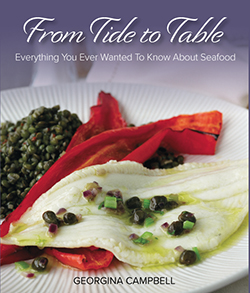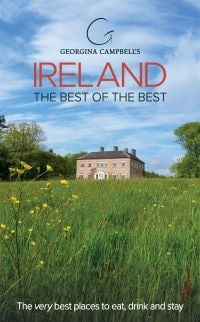Dublin City DUBLIN 18
China Sichuan Restaurant
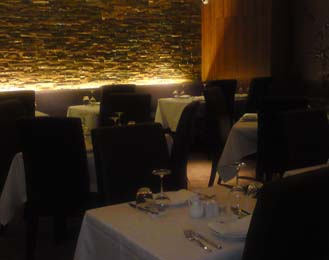
Bistro One
Gables Restaurant, The
Fado Restaurant
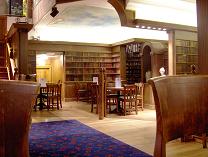
Beacon Hotel, The
AA DUBLIN 18
Bewleys Hotel Leopardstown
South Bar and Restaurant

21 Library Road
 Statuesque echiums and a profusion of unusual plants bursting over the garden wall signal the presence of a promising garden. But the real treat - a sumptuous feast for plant lovers- lies hidden behind Carmel Duignan’s house. For here is a series of the most fascinating conversations going between rare southern hemisphere plants and unusual varieties of more familiar species.
Statuesque echiums and a profusion of unusual plants bursting over the garden wall signal the presence of a promising garden. But the real treat - a sumptuous feast for plant lovers- lies hidden behind Carmel Duignan’s house. For here is a series of the most fascinating conversations going between rare southern hemisphere plants and unusual varieties of more familiar species. Plants talk colour to each other - the metallic blue tinge of Acacia baileyana purpurea speaking in unison with Aconitum ‘Stainless Steel’ and the silver of Buddleja agosthera. Unlikely bedfellows vie with each other to produce the most scintillating associations, the red black of Aeonium arobreum ‘Zwartkop’ smoulders against a lime green tansy. And choice solo numbers like Prostanthera wateriiwith trumpets that glow like pearls in the dusk or prolific golden Tropaeolum ciliatum compete for notice.
On a lime rich sheltered site, the garden, started from a field 17 years ago, is laid out with a strong rectangular framework, the better to contain the glorious profusion of plants. Reds are marshalled to one side of the central lawn and blues to the other, with an arbour at the end as a the focal point. Paths burrow between the main herbaceous borders, punctuated by fountains of roses and clematis grown on pillars, and leafy side borders with unusual plants have inviting seating areas half way along this deeply satisfying voyage around the plant world.
Fuschias, clematis and pseudopanax feature strongly in a collection which stretches all the way from Salvia corugata, with a black calyx and intensely blue flowers, discovered in Ecuador in the last 20 years to Clematis ‘Princess Diana’ with droop headed pink bells who had her title changed just like HRH Princess of Wales.
Knockrose Garden
 Knockrose is situated 500 feet above sea level nestling on the shoulder of The Scalp, a geological feature formed by the melting waters of a glacier. Tom and Trish Farrell are the owners and custodians of this beautifully cultivated unique garden, which is backed by an old mixed forest. Attached to a traditional farmhouse and buildings, it has been evolving over the last seventy years.
Knockrose is situated 500 feet above sea level nestling on the shoulder of The Scalp, a geological feature formed by the melting waters of a glacier. Tom and Trish Farrell are the owners and custodians of this beautifully cultivated unique garden, which is backed by an old mixed forest. Attached to a traditional farmhouse and buildings, it has been evolving over the last seventy years.
Rathmichael Lodge
 Rathmichael Lodge is one of those gardens that wins an “oh!” of pleasure when they first burst into the field of vision. Like sex appeal it’s a quality that is hard to pin down, but whatever it is Corinne and Richard Hewat’s creation has it in spades.
Rathmichael Lodge is one of those gardens that wins an “oh!” of pleasure when they first burst into the field of vision. Like sex appeal it’s a quality that is hard to pin down, but whatever it is Corinne and Richard Hewat’s creation has it in spades. It could be something to do with the allure of a half moon of herbaceous border packed with appealing plants and plant associations; it could be to do with the invitation to explore and find out what happens beyond a Gothic gate - and it could also be the desire to bury one’s nose in one of the dozens of old fashioned roses, or simply the pleasure of sinking onto a strategically placed garden bench and drinking the whole scene in.
The garden is at its peak in June; Corrine loves roses and the garden is full of old fashioned ladies like ‘Adelaide d'Orleans’ , ‘Margaret Merril’ and ‘Mme Isaac Pereire’ . Cottagey plants, like foxglove and alchemilla mollis seed happily in corners and covetable varieties - violas, delphiniums, oriental poppies, thalictrum, hemerocallis - await admiration in the borders.
Festooned in wisteria and particularly exuberant climbing roses, the house forms a backdrop to this informal cottage style garden, and a terrace provides shelter for tender treasures in troughs and pots. Surprises waiting to be discovered include a Millennium Walk leading to a gazebo, a perfectly manicured tennis court and a pair of stone dogs wearing ivy collars.
Stillorgan Park Hotel
Burton Hall
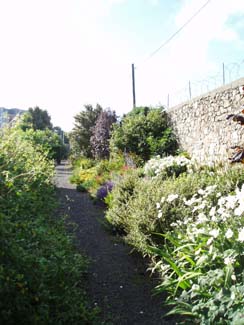 An oasis in the midst of a commercial hub, the fine old walled garden of 1731 Burton Hall has a new incarnation as a teaching garden and is part of the training and rehabilitation programme for Cluain Mhuire.
An oasis in the midst of a commercial hub, the fine old walled garden of 1731 Burton Hall has a new incarnation as a teaching garden and is part of the training and rehabilitation programme for Cluain Mhuire. There are lots of enjoyable things for visitors to learn there too: how to revive an ancient bay hedge, how to run a square foot vegetable garden and effective ways to ward off pests with companion planting.
Replanted from 1995 with begged and stolen plants (guaranteed to grow), the garden has matured beautifully. Yew, bay and beech hedges delineate different areas within the garden: an arboretum, a parterre, a fruit garden, and a central walk bordered with lavender, penstemons and R‘Perle d’Or’.
The vegetable garden is planted with unusual crops like physalis, pumpkins, Chinese mustard, purple podded peas and Pak Choi. Around the walls are glorious herbaceous borders with interesting plant associations Chephalaria gigantea, eremerus with yellow thalictrum and Romneya coulteri, named after Romey and Coulter the two Irish men who discovered it.
Burton Hall is also a place where children can marvel at the tallest of trifid-like echiums, where strollers can sit on intriguing sculptured seats by James Carroll and see statuesque Puja chilensis,which grabbed the headlines as one of the first to flower in Ireland.
Tempting plants propagated from the garden can also be purchased.
Fernhill Garden
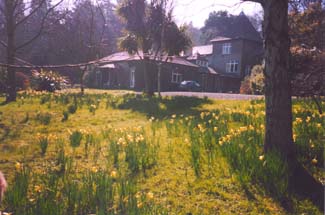 It is perfectly possible to forget the encroaching suburbs and to lose yourself to fantasy in this lovely oasis on the side of the Three Rock Mountain overlooking Dublin Bay. You might imagine yourself awaiting the arrival of the butler with afternoon tea at the end of the broad walk, as the Darley family did around the time the now giant Wellingtonias and Tsugas were planted there in 1860.
It is perfectly possible to forget the encroaching suburbs and to lose yourself to fantasy in this lovely oasis on the side of the Three Rock Mountain overlooking Dublin Bay. You might imagine yourself awaiting the arrival of the butler with afternoon tea at the end of the broad walk, as the Darley family did around the time the now giant Wellingtonias and Tsugas were planted there in 1860. Equally you could be in the Himalayas marvelling at the spring display of rhododendrons in every shade from the towering cerise of R. arboretumto the yellow of R. genestieranumamong the glades of the rocky hillside. Or pretend that you are following in the footsteps of plant explorer George Forrest when he discovered the rose red flowered Camellia reticulatain China in 1924.
The 40 acre estate has been owned by the Walker family since 1934, when RJ Walker began planting a magnificent collection of tender and exotic shrubs in the grounds laid out by the Darleys in the previous century. A series of mysterious trails add to the sense of discovery as different areas create changes of mood. On entering, there is the old world charm of the kitchen garden, hedged in beech with a grid of paths running between herbaceous borders, espaliered fruit trees and vegetable beds.
The stream garden, bright with candelabra primula in spring, leads on to an Edwardian rockery with a central pool feature and planted with bulbs, ericas and dwarf shrubs. The route wanders on to a sheltered area where trilliums and hellebores have colonised beneath acers and camellias. Within the garden you can move from continent to continent courtesy of plants: in one minute you seem to be in an Australian forest amid woolly tree ferns, the next in China beside fragrant water lily like flowers of Michelia doltsopa.
Magnolias provide some of the most unforgettable sights, like the huge flamingo pink flowers of M. campellii, borne on bare branches in early spring, or the ballerina like skirts of M wilsonii dancing in a grove on the hillside.
Box Tree, The, & The Wild Boar
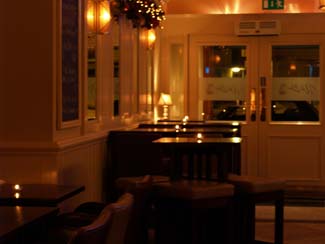
Pielows Restaurant
Thomas's
Imaginosity - Dublins Children Museum
 Children learn best when they're having fun and with this ethos in mind Imaginosity champions the 'hands-on, minds-on' philosophy that encourages all visitors to get involved and have fun while learning and create positive and lasting memories.
Children learn best when they're having fun and with this ethos in mind Imaginosity champions the 'hands-on, minds-on' philosophy that encourages all visitors to get involved and have fun while learning and create positive and lasting memories. Imaginosity is Ireland's only interactive children's museum for the under 9's and has 2.5 floors of exhibits that are educationally designed to inspire life-long learning through play, celebrating children’s imaginations on the journey from curiosity to discovery.
Leopardstown Racecourse
 Leopardstown Racecourse is well known horse racing venue that is located about 8km south of Dublin city centre. Like the majority of Irish courses Leopardstown hosts both National Hunt and Flat racing totalling about 22 meetings per year.
Leopardstown Racecourse is well known horse racing venue that is located about 8km south of Dublin city centre. Like the majority of Irish courses Leopardstown hosts both National Hunt and Flat racing totalling about 22 meetings per year.
La Rouge Wine & Grill
Cabinteely Park Market - Co Dublin - Sundays
Cabinteely Park - Sundays - 10am-4pm
Cabinteely House is an 18th century Demesne house set in 45 hectares of Parkland. The Park boasts a great playground, extensive walking trails and a Japanese Garden.
Within the courtyards of the House, the Council has refurbished a former Grainstore for the promotion and development of Youth Arts in the County, the Courtyard of which houses a family friendly café.
The Market will be located outside the Grainstore Courtyard.
Contact Us
Telephone: 01 204 7024
Email: market@dlrcoco.ie
Website: www.dlrcoco.ie/markets
Catch, The
Coffee Shot, The
Step Inn, The
Wildeside Cafe
Woodruff

Eleven, at Whelehans Wines
TAPA
Show me all Dublin City


